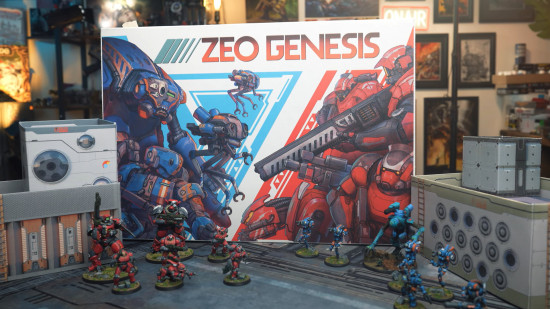Zeo Genesis, a mech miniatures game designed by Warhammer 40k veteran Andy Chambers, with a narrative by fellow ex-GW legend Gav Thorpe, is set to launch this year. When we first reported on ZG almost two years ago, publisher Best Hobby pledged to use proper injection-molded hard plastic for the miniatures – and according to a new trailer, it’s making good on its word.
Zeo Genesis is a skirmish game that puts its focus squarely on the mechs, or ‘Zeos’ in the game’s terminology. When we spoke to company founder Daniel Block back in 2023, he said that the best analogy to Warhammer 40k would be “playing a game with all dreadnoughts and having two or three Space Marines or Imperial Guard with each”.
The human size figures are there, in part, to make the Zeos look appropriately huge. Their slightly rounded industrial design comes from concept artist Dan Morison – some of you may know him for his excellent, chunky fan art of various Space Marine chapters.
While the models in the trailer are 3d printed prototypes, Block states that the Best Hobby team has spent “the last three years building a small factory” in the United States “to be able to do all of the milling, molding, and injection ourselves”. If all goes to plan, they will be in full control of making injection molded plastic kits for the game, just like Games Workshop is.

That is a truly remarkable investment. As we found out in our back-stage tour of UK mini maker Mantic Games, individual injection molds are each a four figure investment that must be precisely engineered. That’s not even considering the cost of the injection machines that use the molds. It’s telling that, despite having a very large catalogue of plastic miniatures, Mantic outsources its plastic manufacturing to specialist production partners.
Zeo Genesis will launch first via Gamefound, with the campaign page set to launch “soon”. Playtest rules for Zeo Genesis are already available from the game’s website. We’ve only had time to scan them so far, but the core rules seem very intriguing.
For one thing, there’s no turn sequence. Each model has a number of activation points, and players take it in turns spending these points to activate a model. Once all their models have spent up their action points, players must spend a turn doing nothing to refresh the points.
Models can also spend their action points to respond to enemy actions in a variety of ways. If a model is shot at, it could choose to fire back, try to dodge out of the attack’s line of sight, or hunker down against the fire.
That seems like it will force interesting decisions. Is it worth spending an action point, or one of your force’s limited supply of shared ‘Impetus Points’, to push the offensive with a model, or is it more important to remain flexible and hold it for defense?
We haven’t tested it yet, but we want to – it seems like a kinetic and dynamic system. We’re particularly interested as long term fans of Andy Chambers’ work, because it seems quite different from what he’s made before.
For the younger wargamers in the audience, Andy Chambers was part of the Games Workshop design studio from the 1990s to the mid ‘00s, with design credits on Warhammer 40k, Warhammer Fantasy Battles, the army books for many Warhammer 40k factions and Warhammer Fantasy armies, plus many beloved spin-off games.
Since leaving GW he’s worked on some of the best miniature wargames, including Bolt Action, Dropfleet Commander, and Blood Red Skies.
Chambers is joined by another GW exodite, Gav Thorpe, who is the Zeo Genesis’ narrative lead. The setting for the game is the human occupied Hundred Suns, a group of heliospheres that are collectively isolated from the wider galaxy by a mysterious barrier – its creators remain unknown. The tone isn’t grimdark, but this is definitely a military sci-fi setting with some mysteries.
This is a game we’re following with interest. We’re also very keen to see another project that Thorpe and Chambers are working on together: a new edition of Weird War Two wargame Konflikt ‘47.
Source: Wargamer




